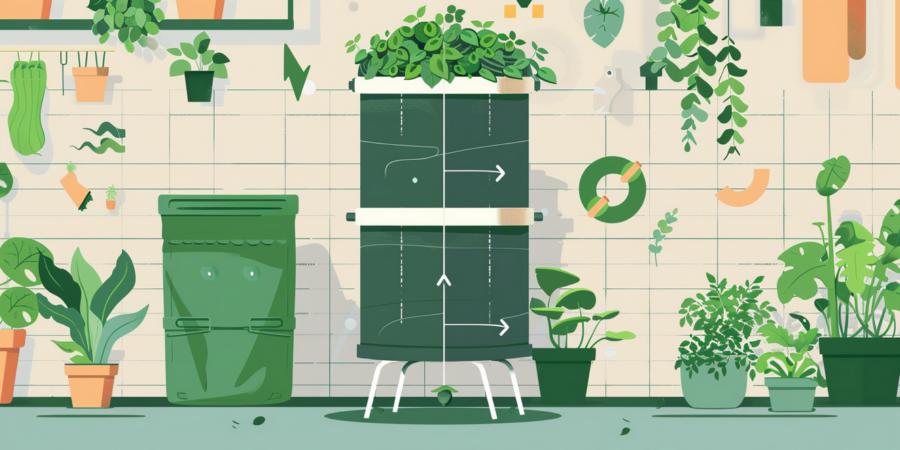Fabric Pots: The Unsung Heroes of Airflow
Worm bins traditionally come in plastic tubs that are about as breathable as a concrete sock. Enter the humble fabric grow bag — designed for plants but surprisingly excellent for worms. These bags allow air to move freely through the sides, helping moisture evaporate naturally and reducing the risk of anaerobic conditions.You don’t need to splurge on fancy grow bags either. Thrift stores, gardening swaps, or even old reusable grocery bags (as long as they’re breathable fabric) can be converted into budget worm havens. Just make sure there’s enough structural support to keep the bin from slumping like a teenager at a family reunion.
Not only does the breathable fabric help regulate moisture, it also provides airflow on all sides — something most plastic bins can’t manage without power tools and a reckless disregard for warranties. And because the fabric dries out faster than plastic, it discourages excess condensation and that dreaded bin-stank.
Raising the Bar with Wire Racks
Placing your worm bin directly on the ground is a bit like sleeping in a wet tent — technically doable, but everything suffers. Elevating your bin on a wire rack instantly improves airflow underneath, helping moisture escape and discouraging pests like ants, mites, and the ever-tenacious fruit fly.Wire racks allow for 360-degree air circulation — top, sides, and crucially, the bottom. Gravity does its job more effectively when excess liquid can drain freely, especially if your bin has holes or mesh at the base. Even closed-bottom bins benefit from being lifted; the air around them stays drier and less inviting to those creepy-crawlies that weren’t on the guest list.
You don’t need to buy anything fancy. An old oven rack perched on bricks, a retired milk crate, or even a forgotten shoe rack can become a worm bin pedestal. Just make sure the structure is stable — worms are shockingly bad at surviving sudden drops, and they won’t appreciate a floor collapse mid-meal.
Mix It Up: Hybrid Hacks That Actually Work
Of course, nothing stops you from combining these approaches. A fabric grow bag sitting on a wire rack? That’s not just practical — it’s practically luxury. Think of it as the worm equivalent of a breathable mattress on a slatted frame. You’re giving your composting crew the airflow they need to stay active and healthy.If you’re feeling experimental, try putting a mesh basket inside a fabric pot — double the air exposure, double the drainage. For people in humid climates, this layering helps avoid fungal build-up and wet clumping. It’s also a clever way to portion out compost by zone, if you’re that kind of organized chaos gardener.
Avoiding Moisture Mayhem
Even with great aeration, it’s shockingly easy to waterlog your worm bin. Between juicy food scraps, overzealous misting, and rainy-day neglect, moisture builds up fast. While fabric pots and elevation help, it’s still essential to monitor what’s going in.Chop up scraps to reduce the risk of soggy dead zones. Mix in dry bedding like shredded cardboard or coir regularly. If your bin starts looking more like a soup than a salad, you’ve got a problem. Worms can’t swim, and while they might tolerate a little puddling, you’ll know it’s gone too far when they start scaling the walls in protest like tiny escape artists.
Pro tip: always keep an eye on the “squeeze test.” Grab a handful of bedding and give it a firm squeeze — it should feel like a wrung-out sponge. If water drips out, time to add dry material. If it crumbles to dust, moisten slightly. This old-school method is still more reliable than any gadget you could overpay for online.
What About Lids?
There’s debate in worm composting circles (yes, they exist) about lids. Some say a tight lid keeps pests out. Others argue that it traps too much moisture and heat. The middle ground? A loose-fitting lid with ventilation holes or even just a piece of breathable cloth laid over the top.For fabric pots, lids become even less necessary. These setups already allow for passive airflow and moisture regulation, especially when combined with elevation. Just make sure your bin stays out of direct sun and heavy rain if it’s outdoors. Worms don’t appreciate surprise saunas or unintended baths.
Common Pitfalls to Dodge
Aeration alone won’t save your bin from other classic composting blunders. People sometimes throw in greasy leftovers, dump in a week’s worth of citrus, or forget about their bin for three months — then blame the worms when things go sideways.Keep your inputs balanced. That means roughly equal parts “greens” (food waste) and “browns” (carbon-rich bedding). Stir the bin gently every couple of weeks. This helps distribute oxygen without ruining the worms’ carefully curated architecture.
And don’t forget: ventilation holes on plastic bins are not optional. If you’re not using a fabric pot, take the time to drill side and bottom holes. Otherwise, you’re basically inviting anaerobic bacteria to a rave, and they don’t leave quietly.
Bin There, Done That
Worm composting can be incredibly low-maintenance — if you nail the airflow. Fabric grow bags and wire racks are cheap, easy, and weirdly satisfying solutions. They transform bins from sad plastic coffins into thriving, odor-free ecosystems.Get creative with the materials. Hit the thrift store. Flip that busted dish rack into a ventilation superstar. Give your worms a breathable home, and they’ll reward you with some of the richest compost imaginable — no overpriced system required.
Of course, they won’t thank you. They’re worms. But if you listen closely enough, you just might imagine their little bodies wriggling in joy.
Article kindly provided by The Worm Hub

